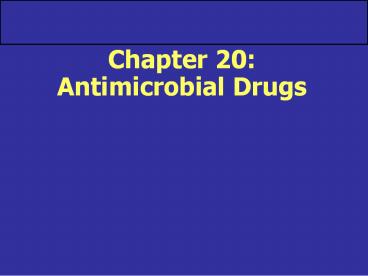Chapter 20: Antimicrobial Drugs - PowerPoint PPT Presentation
1 / 28
Title: Chapter 20: Antimicrobial Drugs
1
Chapter 20Antimicrobial Drugs
2
Antimicrobial Drugs
- Chemotherapy The use of drugs to treat a
disease - Antimicrobial drugs Interfere with the growth of
microbes within a host
3
- Antibiotic Substance produced by a microbe
that, in small amounts, inhibits another microbe
Table 20.1
4
www.textbookofbacteriology.net
5
- 1928 Fleming discovered penicillin, produced
by Penicillium (mold) - First clinical trials in early 1940s
Figure 20.1
6
Broad-spectrum antibiotics those that affect a
broad range of gram-positive and/or gram-negative
bacteria
Table 20.2
7
Antimicrobial DrugsSelective Toxicity
- Selective toxicity property of a drug that
allows it to kill microbes without damaging the
host cells - Takes advantage of differences in cell structure
and metabolism between the microbe and host cells - Antibacterials target prokaryotic structures
- Penicillin prevents proper synthesis of
peptidoglycan
8
The Action of Antimicrobial Drugs
- Bactericidal causes death of bacteria
- Bacteriostatic prevents growth of bacteria
9
Targets of Antimicrobial Drugs
Figure 20.2
10
Targets of Antimicrobial DrugsCell wall
synthesis
- Penicillin weakens bacterial cell walls by
inhibiting the crosslinking of peptidoglycan - Peptidoglycan is found only in bacterial cell
walls - Bactericidal (must be actively growing)
11
Targets of Antimicrobial DrugsCell Wall
Synthesis
- Penicillins
- Natural penicillins
- Isolated from Penicillium mold
- Narrow spectrum of activity
- Susceptibility to penicillinases (or
ßlactamases) - Semisynthetic penicillins
- Chemically add new side chains to nucleus in
attempt to - reduce susceptibility to penicillinase
- extend their spectrum of activity
12
Targets of Antimicrobial DrugsCell Wall
Synthesis
- Penicillins
- Semisynthetic penicillinase-resistant penicillins
- Methicillin was the first
- Resistant strains of staphylococci have become
prevalent MRSA (methicillin-resistant
Staphylococcus aureus)
13
Targets of Antimicrobial DrugsProtein Synthesis
- Exploit 70S ribosomes of prokaryotic cells
- Eukaryotic (host) cells 80S ribosomes
- Host side effects due to mitochondrial toxicity
(mitochondria 70S)
Figure 20.4
14
Targets of Antimicrobial DrugsProtein Synthesis
- Tetracyclines
- Broad spectrum of activity
- Inhibit the association of tRNAs with the 70S
ribosome - Prevent the addition of amino acids to the
growing protein chain - Bacteriostatic
http//student.ccbcmd.edu/courses/bio141/lecguide/
unit2/control/images/tetres.gif
15
Other Targets of Antimicrobial Drugs
- Plasma membranes
- Drugs increase membrane permeability
- Nucleic acid synthesis
- May affect mammalian nucleic acid synthesis as
well - Essential metabolite synthesis
- Competitive inhibitors that prevent production of
metabolites that are essential for
growth/survival of the microbe
16
Testing effectiveness of antibiotics on
bacteriaDisk-Diffusion Test
- Zone of inhibition diameter reflects
susceptibility of test organism to antibiotic drug
Figure 20.17
17
Effects of Combinations of Drugs
- Antagonism the effect of two drugs together is
less than the effect of either alone - Synergism the effect of two drugs together is
greater than the effect of either alone - i.e. Polymyxin (membrane-disrupting drug) makes
it easier for streptomycin to enter the cell
18
Effects of Combinations of Drugs
Figure 20.22
19
Antibiotic Resistance
- Cellular mechanisms of antibiotic resistance
- 1. Prevention of penetration of drug into cell
- 2. Alteration of drug's target site (Mutation)
- 3. Enzymatic destruction of drug
- 4. Rapid ejection of the drug (Efflux)
- Resistance genes are often on plasmids that can
be transferred between bacteria - 1968 12,500 Guatemalans died of Shigella
diarrhea - This strain contained a plasmid with resistance
to four antibiotics
http//www.fda.gov/cvm/antiresistvideo.htm
20
Emergence of Antibiotic-resistant mutant bacteria
- Antibiotic-resistant bacteria replacing the
sensitive population - Every time an antibiotic is used, sensitive
bacteria are killed, and resistant bacteria may
survive and continue to grow (repopulate) - Presence of the antibiotic provides selective
pressure - Selecting for antibiotic-resistant bacteria
- Survival of the fittest
Figure 20.20
21
Infection
Antibiotic Administration
Inappropriate dose/duration
Appropriate dose/duration
Evolution of the surviving bacterial
population -SELECTIVE PRESSURE -Sensitive cells
die -Resistant cells survive, grow
Extinction of the whole bacterial
population -Sensitive cells die -Resistant cells
die
22
MRSA
- About half of S. aureus infections in US are
resistant to penicillin, methicillin,
tetracycline, and erythromycin - Methicillin-resistant Staphylococcus aureus
- Frequently used to describe S. aureus strains
resistant to all penicillins - Quite common in hospitals
- Current treatment for MRSA is vancomycin, the
last weapon in the arsenal - VRSA was reported in 1997, and is (slowly) on the
rise - As more antibiotics are discovered/synthesized,
bacteria continue to adapt by developing and
sharing antibiotic resistance
23
MRSA infections small red bumps ? deep, painful
abscesses
http//www.mayoclinic.com/images/image_popup/ans7_
staph_skin.jpg
24
Antibiotic Resistance
- One of the worlds most pressing health problems
- Misuse of antibiotics selects for resistant
mutants Misuse includes - Using outdated, weakened antibiotics
- Using someone else's leftover prescription
- Failure to complete the prescribed regimen
- Using antibiotics for the common cold and other
inappropriate conditions - Use of antibiotics in animal feed
?Each of these applies selective pressure on a
microbial population, favoring resistant cells.
25
Acquisition of fluoroquinolone (FQ)-resistant
Campylobacter from poultry.
- FQ approved for use in poultry in 1995
- FQ use discontinued in 2001
www.cdc.gov/ncidod/EID/vol10no6/04-0403-G.htm
26
Strategies to Reduce Emergence of
Antibiotic-resistant bacteria
- Prescription of antibiotics only when it will
likely benefit the patient - Use an agent with narrow spectrum of activity
when possible - Use antibiotics at the proper dose and duration
27
http//www.nearingzero.net/screen_res/nz149.jpg
28
(No Transcript)































